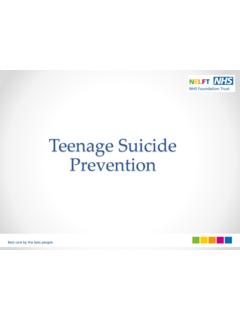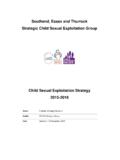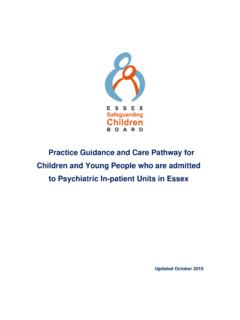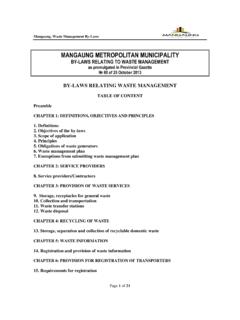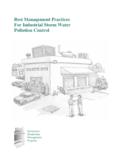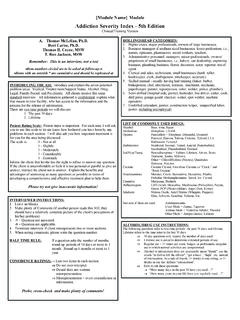Transcription of PREVENT Policy and Guidance
1 PREVENT Policy and Guidance Southend Safeguarding Adults Board Essex Safeguarding Adults Board Thurrock Safeguarding Adults Board Southend Safeguarding Children Board Essex Safeguarding Children Board Thurrock Safeguarding Children Board Jan 2017. Version 1. Document Control Sheet Title: PREVENT Policy and Guidance Purpose: A guide for local partnerships and agencies in Southend Essex and Thurrock in preventing radicalisation Type: Operational Policy and Guidance Target Audience: All professionals working in Southend, Essex and Thurrock Date approved: December 2016. Review Date: December 2017. This replaces: n/a This should be read This Policy is compliant with all relevant legislation at the alongside: time of publication and adheres to the current SET Safe- guarding Adults Guidelines and SET Safeguarding and Child Protection Procedures.
2 Leads / Authors: Paula Ward (ESAB). Sophie Scollen Essex County Council (ECC). Heather Williams Essex County Council (ECC). 2. Contents 4. Introduction .. 4. Definitions .. 4. Information Sharing .. 5. 5. 6. Channel Panel Process .. 6. Assessing 6. Identifying Vulnerable 7. 8. Referral Process .. 9. Transfer 100. Referral Flowchart .. 12. Risk and Intervention 142. Working with Partner Agencies .. 144. Channel Panels .. 15. Case Management, Recording, Supervision and Support .. 155. Training .. 15. Annex A - Blank Vulnerable to Radicalisation Referral form .. 16. Annex B - PRVENT and CHANNEL leads/administrators .. 16. 3. Policy Introduction CONTEST is the overall UK strategy for Countering Terrorism. The aim of CON- TEST is to reduce the risk to the UK and its interests overseas from terrorism, so that people can go about their lives freely and with confidence.
3 It has four work streams, of which PREVENT is one. The purpose of the PREVENT Strategy is to stop people becoming terrorists or supporting terrorism. The strategy addresses all forms of terrorism and focuses work to PREVENT radicalisa- tion on three key objectives: Challenging ideology that supports terrorism;. Protecting vulnerable individuals; and Supporting sectors and institutions where there is a risk of radicalisation. For further information see PREVENT Duty Guidance for England and Wales Channel is a key element of the PREVENT strategy. It is a multi-agency approach to protect people at risk from radicalisation. Channel uses existing collaboration be- tween local authorities, statutory partners (such as the education and health sectors, social services, children's and youth services and offender management services), the police and the local community to: Identify individuals at risk of being drawn into terrorism.
4 Assess the nature and extent of that risk;. Develop the most appropriate support plan for the individuals concerned. For further information see Channel Duty Guidance for England and Wales Definitions These definitions are taken from the HM Government PREVENT Strategy 2011. Radicalisation is defined as the process by which people come to support ter- rorism and extremism and, in some cases, to then participate on terrorist ac- tivity. Extremism is vocal or active opposition to fundamental British values including democracy, the rule of law, individual liberty and mutual respect and tolerance of different faiths and beliefs. We also include in our definition of extremism calls for the death of members of the armed forces. 4. Information Sharing Information sharing must be assessed on a case-by-case basis and is governed by legislation.
5 To ensure the rights of individuals are fully protected, it is important that information sharing agreements are in place at a local level. When considering shar- ing personal information, the specified authority should take account of the following: necessity and proportionality: personal information should only be shared where it is strictly necessary to the intended outcome and proportionate to it. Key to de- termining the necessity and proportionality of sharing information will be the pro- fessional judgement of the risks to an individual or the public;. consent: wherever possible the consent of the person concerned should be ob- tained before sharing any information about them;. power to share: the sharing of data by public sector bodies requires the exist- ence of a power to do so, in addition to satisfying the requirements of the Data Protection Act 1998 and the Human Rights Act 1998; Data Protection Act and the Common Law Duty of Confidentiality: in engaging with non-public bodies, the specified authority should ensure that they are aware of their own responsibilities under the Data Protection Act and any confidentiality obligations that exist.
6 There may be some circumstances where specified authorities, in the course of Pre- vent related work, identify someone who may already be engaged in illegal terrorist- related activity. People suspected of being involved in such activity must be referred to the police. For Guidance on information sharing speak with your manager in the first instance. Recording Your organisations case management and recording policies should be followed in respect of PREVENT casework. 5. Guidance Channel Panel Process The role of the multi-agency panel is to develop an appropriate support package to safeguard those at risk of being drawn into terrorism based on an assessment of their vulnerability. The panel is responsible for managing the safeguarding risk which is in line with other multi-agency panels where risk is managed, such Multi-Agency Public Protection Arrangements (MAPPA).
7 The panel should be chaired by the local authority PREVENT lead (see Annex B for lo- cal authority contact details) and include the Essex Police and other relevant statuto- ry partners. Channel is not a process for gathering intelligence. It is a process for providing sup- port to people at risk. In common with other such programmes, it does require the sharing of personal information to ensure that the full range of an individual's vulner- abilities are identified and addressed. Information sharing must be assessed on a case by case basis and is governed by legislation. It is not the purpose of Channel to provide an alternative to the criminal justice sys- tem for those who have been engaged in illegal activity. Channel is about early inter- vention to protect and divert people away from the risk they may face before illegality relating to terrorism occurs.
8 Therefore, in line with other safeguarding processes, be- ing referred to Channel will not lead to an individual receiving a criminal record as a consequence of the referral, nor as a result of any support they may receive through Channel. Assessing Vulnerability Channel assesses vulnerability using a consistently applied vulnerability assessment framework built around three dimensions: Engagement with a group, cause or ideology;. Intent to cause harm;. Capability to cause harm. The dimensions are considered separately as experience has shown that it is possi- ble to be engaged without intending to cause harm and that it is possible to intend to cause harm without being particularly engaged. Experience has also shown that it is possible to desist (stop intending to cause harm) without fully disengaging (remain- ing sympathetic to the cause); though losing sympathy with the cause (disengaging).
9 Will invariably result in desistance (loss of intent). The three dimensions are assessed by considering 22 factors that can contribute to vulnerability (13 associated with engagement, 6 that relate to intent and 3 for capa- 6. bility). These factors taken together form a rounded view of the vulnerability of an i n- dividual that will inform decisions on whether an individual needs support and what kind of support package may be appropriate. These factors can also be added to and are not considered an exhaustive list. By undertaking regular vulnerability as- sessments the progress that is being made in supporting an individual can be tracked through changes in the assessment. Identifying Vulnerable People Completing a full assessment for all 22 factors requires thorough knowledge of the individual that may not be available at the point of the initial referral (see Vulnerable to Radicalisation (VTR) Referral Form at Annex A).
10 However, there are a number of behaviours and other indicators that may indicate the presence of these factors. Example indicators that an individual is engaged with an extremist group, cause or ideology include: Spending increasing time in the company of other suspected extremists;. Changing their style of dress or personal appearance to accord with the group;. Their day-to-day behaviour becoming increasingly centred around an extremist ideology, group or cause;. Loss of interest in other friends and activities not associated with the extremist ideology, group or cause;. Possession of material or symbols associated with an extremist cause ( The swastika for far right groups);. Attempts to recruit others to the group/cause/ideology. Communications with others that suggest identification with a group/cause/ideology.


